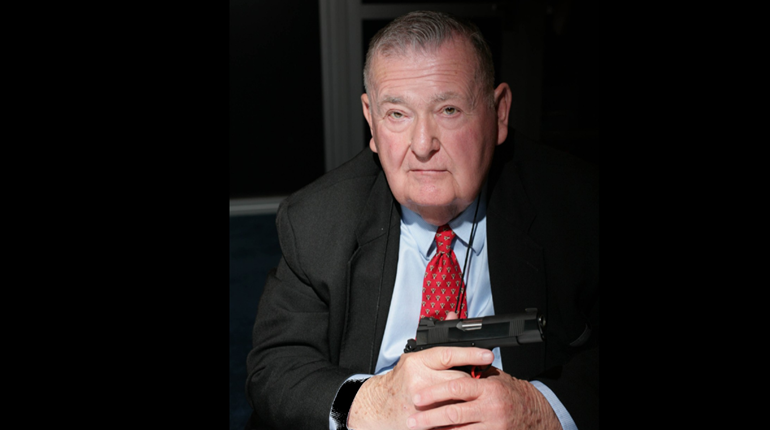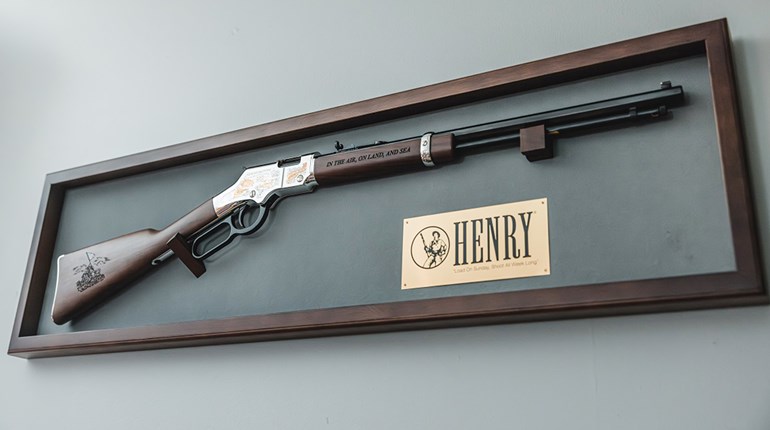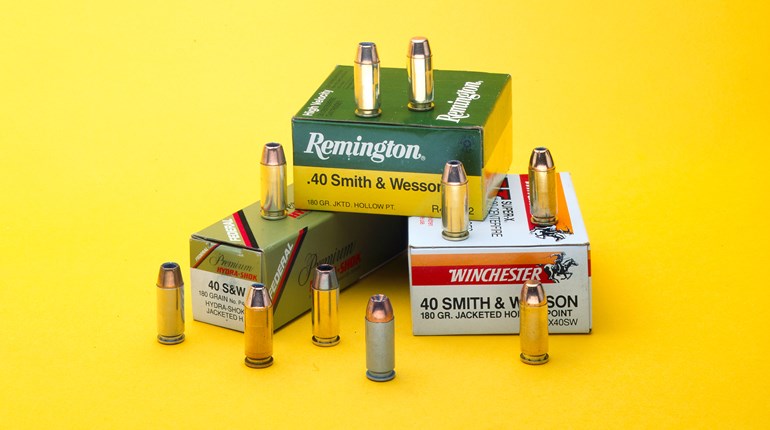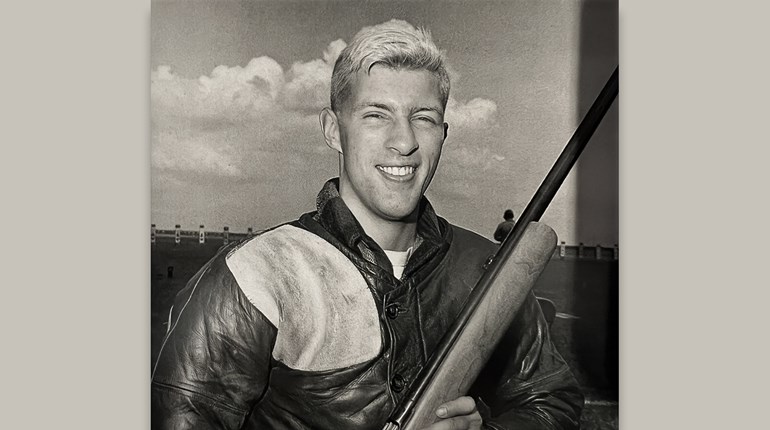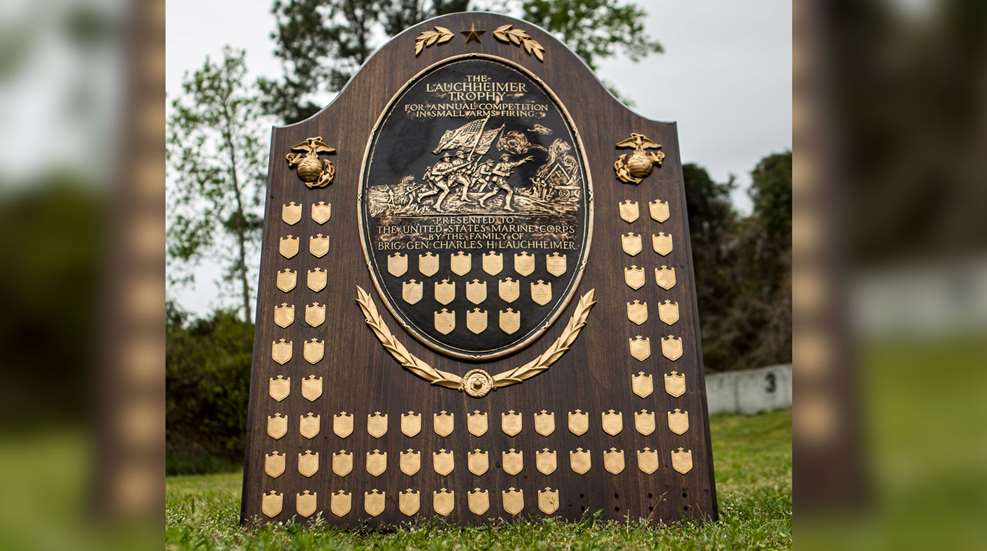
Indicative of his prowess with handgun and rifle, Capt. Bob Martin was a two-time winner of the Lauchheimer Trophy, awarded to the Marine with the highest score in both rifle and pistol competition in Marine Corps matches.
When Capt. Bob Martin walked through the company-office door that first time, the silence was deafening. In a perfectly tailored green uniform, topped with four rows of campaign ribbons, he was an imposing Marine and Company K’s new Commanding Officer. Below the ribbons identifying combat service in World War II and Korea, there were three shooting medals—gold shooting medals. In those days (1958), gold medals signified competition-proven Distinguished Rifleman and Distinguished Pistol Shot. They are rarely seen, but the third gold was even more rare. It was the Lauchheimer Trophy, awarded to the highest combined score with both rifle and pistol at the annual Marine Corps matches. Capt. Martin was an experienced professional officer with multiple skills—heavy on marksmanship and weaponry.
In the following months, I served under this impressive officer and learned a great deal from Capt. Martin. Much of what I learned had to do with our standard firearms—Browning’s Light Machine gun and Automatic Rifle, plus the M1 Garand rifle. These three arms fired the standard .30-caliber cartridge, commonly dubbed the .30-’06 Sprg. This legendary round had a maximum effective range in the hundreds of yards. I was more interested in what the Marine Corps had ordained to be my issued arm—the M1911A1 .45 ACP pistol. While official competitive shooting involved slow-fire work at 50 yards, annual qualification never put the bullseye target beyond 25 yards.
I was interested in how far the plain M1911A1 could be employed. At an open range on the east side of Okinawa one afternoon, I saw Capt. Martin get three consecutive hits on a silhouette target waaaay out there. He took the gun right out of my holster (so I’d have to clean it) and he needed one ranging shot to get on. With no means of measuring the distance, we had to estimate a conservative 150 yards. The pistol was not a match gun and the ammo was G.I. ball. The shooter was the key—two-time winner of the Lauchheimer.
It may be unlikely that such a shot would ever be required in a battle situation, but that long-ago demonstration of precision pistoleering has long been a preoccupation with me. Certainly, better guns (with better sights) and premium ammunition might have extended Martin’s range, but the shooter is the key. The main advance of the handgun is its portability. At likely distances, most uniformed personnel can develop reason-able skill with a firearm that can be carried on their person. When the range to the target is extended, a rifle is a far better firearm for the job. But, what happens when you don’t have a rifle? With a thorough understanding of the handgun’s trajectories and management, most shooters can learn to make some really long shots.
First, let’s look at what modern handguns are capable of doing. For many years as a gunwriter, I have relied upon the Ransom Rest—properly set up and operated. Usually, the distance is 25 yards, sometimes as much as 50 yards. But the nature of the device—holding a handgun with near-perfect, shot-to-shot consistency—is the same at any range. I recall a shoot with a premium revolver, a Dan Wesson .44 Mag., that was shooting six-shot groups close to a half-inch at 25 yards. In theory, shooting at four times the distance should produce groups four times the size. That is exactly what happened when I moved the target out to 100 yards. The gun (and Pro Load ammo) produced a 1.96-inch group.
One interesting aspect of this long-range handgunning is the sport of International Handgun Metallic Silhouette Association (IHMSA). Originally developed some 50 years ago, this style of shooting at 50, 100, 150 and 200 meters involves knocking down the silhouettes of various game animals. Although this game has evolved toward an equipment race of sorts, it still requires a high level of skill with a handgun. Somehow, IHMSA shooters have managed to keep their sport open to nearly anyone, and there is an unending camaraderie to the matches. A lot of good Americans have had a lot of enjoyment in this unusual sport in the half-century of its existence.
In the tactical sense, it is clearly possible to use today’s military and police service pistols for some pretty long shots. It should be obvious that there is a point at which a handgun bullet surrenders its forward drive to the force of gravity and the bullet drops to the ground. At a couple hundred yards, you have a better chance of making the shot with a long-barreled magnum revolver than with the best of semi-automatics. That longer barrel gives you a longer sight radius for improved aiming. It also gives you a bit more velocity for a longer possible range. But, the longer tube means the bullet is in the barrel longer, so your follow-through is of critical importance. In some instances, a shorter barrel can sometimes be more accurate than a longer one. MG Julian Hatcher proved this a long time back.
There are quite a few tricks and techniques to this aspect of tactical handgunning. And, back in the day, I saw it done to superb effect—with real fightin’ iron.












